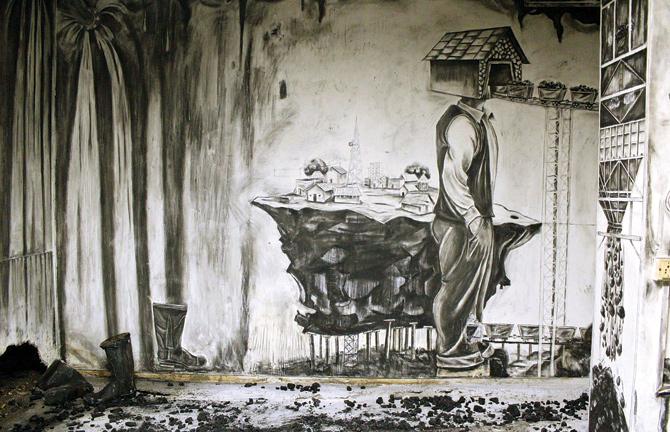Overseas, dead mines have been turned into wine cellars and wedding venues. From a family of farmers-turned-coal miners, artist Prabhakar Pachpute is ready to look ahead and ask, what next?

Pachpute's first solo in Mumbai, held at Clark House in 2012, observed the lives of Chandrapur's miners. Pic/Clark House Initiative
Standing underneath the dome of the National Gallery of Modern Art (NGMA) in Colaba, we listen to what sounds like the summer buzz of insects. It's Mumbai-based Prabhakar Pachpute scratching away with charcoal pencils, bringing life to a wasteland on the wall of the third floor rotunda. The reverberating murmur, we imagine, is a fitting background score to his upcoming exhibition at the famed gallery.

Opening tomorrow, 'no it wasn't the locust cloud' is curated by Zasha Colah and Luca Cerizza and heralded as Pachpute's "first institutional solo". It is a defining moment in the 30-year-old artist's career, which spans four international festivals, two solos in Mumbai and Kolkata, and a number of group shows. But, for now, Pachpute is focused on the circular wall, the largest canvas he has worked on. Adding finishing details to the 11-part surreal story splashed on the wall, he says, "The title is meant to evoke a question from visitors. If it wasn't the locusts, then who is responsible for the situation of the coal mines? Who are the real land-eaters?"
His hands and face are stained with black dust, and charcoal is more than just the medium he works with. It is the very substance of his art.

Calling NGMA's rotunda his largest canvas yet, Pachpute started work on it on March 29. The murals, made of charcoal and pastels, will be washed away when the exhibition ends. Pics/Atul Kamble
Born into a family of farmers-turned-coal miners in Sasti, Chandrapur district of Maharashtra, Pachpute has consistently evoked the landscape of his hometown. Canary in a Coal Mine, his first solo show in 2012, observed the lives of coal miners in Chandrapur. The characters from that show — miners with lamp-heads, drones and owls — resurface in the new site-specific exhibition, but Pachpute has expanded his geography. He now observes the afterlife of mining.
Second life of a mine
Looking at transformations, the last few years have made Pachpute into a resourceful opportunist of this underworld. Last year, while showing his works at the Istanbul Biennial, he visited the 5,000-year-old salt mines in Cankiri, supposed to last for the next 400 years. After the Sao Paulo Biennial 2014, he explored the iron mines and gold mines on the edge of the Amazon. During a residency in Florence in 2013, he visited the famed marble mines of Carrara, from where the stuff of the Italian Renaissance came. But, far from a map of mines, the story he chooses to tell is of a transformed colliery in Germany.
"While exhibiting at The Beast and the Sovereign [in Stuttgart, 2015], I saw photos of the Halde Haniel coal mine in Bottorop, which has been converted into an amphitheatre and a space for public sculptures. There is a need to think along these lines in Chandrapur and the state of Madhya Pradesh. It costs a lot of money to build, say an amphitheatre, but we need to think of alternatives," he says.

Pachpute’s first solo in Mumbai, held at Clark House in 2012, observed the lives of Chandrapur's miners. Pic/Clark House Initiative
Rescuing a wasteland, ravaged by mining, has been experimented the world over. In Poland, the Wieliczka salt mine is now a wedding venue and the Cricova wine cellar in Moldova was once quarried for limestone. For India, Pachpute suggests more utilitarian alternatives. "My grandfather, a farmer, had no option but to turn to mining, a government job with Western Coalfields Ltd. Now, what can we do with a dead mine that is unfit for farming?" he asks.
Over in Chandrapur, there is "an intellectual movement towards collective farming", as Colah puts it. Kishore Kawate, a poet from Rajura, is part of Sapta Ranga, a collective of coal miners and even a chai-seller. The seven-member group, which will perform tomorrow at the exhibition's opening, has been probing the twin issues of mining and farming. Kawate recalls a soyabean crop in 2007 that was defamed after it was fed sewage water from a neighbouring residential quarter for mining officials.
It's twisted, agreed. Even more so, when he speaks of the dangers of dead quarries. "A coal mine in Rajura was closed 15 years ago, but wasn't stable. Water accumulated in it, and there was a risk of people falling in. Then, there was the woman who committed suicide by jumping into it," he says. His Marathi poem, Rahim Uncle and the Goat (Rahim Kaka ani Bakri), is based on this quarry that swallowed people whole. In Pachpute's murals, you will find a reference to this verse.
Not dark as it seems
But, Pachpute's vision is not of a bleak dystopia. "Look at these miners who are hanging on. They are hoping to float away to better lands," he says, drawing our attention a bunch of miners suspended from a cloud. We are not sure that this is a pretty picture of hope, with a stark recall of Vidarbha's farmer suicides. Pachpute allows us our interpretation.
As we walk around the circular canvas, curator Cerizza says, "This circular narrative shows that man can re-transform. Farms become mines, and mines become farms; it's a loop. Is that amphitheatre the end or the beginning?" Then again, it's a question that Pachpute might ask himself; he has come from the fringes of Maharashtra and alternative contemporary art spaces to a national institution with this story of the state.
 Subscribe today by clicking the link and stay updated with the latest news!" Click here!
Subscribe today by clicking the link and stay updated with the latest news!" Click here!










